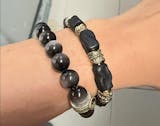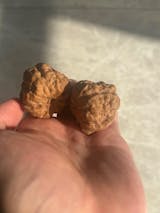How to Distinguish Real Bodhi Root from Fake?
Introduction
Bodhi root, revered in Buddhist traditions and popular in jewelry making, is generally abundant and affordable. While this makes genuine bodhi root readily available, counterfeits still exist in the market. Understanding how to differentiate real bodhi root from fake is crucial for collectors and enthusiasts. This guide will help you identify authentic bodhi root and assess its quality.

What is Bodhi Root?
Bodhi Root is not actually a tree root, but the seed of a palm plant called Corypha umbraculifera, which belongs to the Arecaceae (palm) family. Native to India, Malaysia, and Sri Lanka, this plant is closely connected to Buddhism. In ancient India, followers inscribed scriptures onto its leaves, creating what became known as palm-leaf manuscripts.
The seeds, commonly known as Bodhi Roots, are revered in Buddhist culture and are often crafted into mala beads — prayer beads used for meditation and chanting. The term “Bodhi” means “awakening” or “enlightenment” in Sanskrit, symbolizing the spiritual journey and the pursuit of wisdom. Bodhi root beads are valued not only for their spiritual significance but also for their natural beauty, making them popular among practitioners and collectors alike.

How to Distinguish Real Bodhi Root from Fake?
Bodhi root is generally abundant and affordable, which reduces the likelihood of encountering counterfeit products. However, some fake versions do exist, often made from plastic or glass, and understanding how to distinguish real bodhi root from these imitations is essential for enthusiasts. Below are several effective methods for identifying authentic bodhi root.
1.Visual Inspection
Genuine bodhi root has a natural, slightly uneven color, typically off-white with a yellowish tinge. The color variation across the beads is subtle but noticeable. Fake bodhi root, often made of plastic, tends to have a uniform, artificial color.
2.Texture and Weight
Real bodhi root, unless highly polished, has a slightly rough texture. When held, it feels substantial and has a pleasant weight. As you handle genuine bodhi root beads, they become smoother and develop a natural sheen over time. Fake bodhi root, particularly plastic imitations, feels lighter and maintains its initial texture regardless of use.
3.Scent Test
When gently heated or rubbed, real bodhi root emits a subtle, pleasant aroma reminiscent of roasted corn. Fake bodhi root, especially plastic versions, may produce a chemical odor or no scent at all.
4.Sound Check
Authentic bodhi root beads produce a soft, muted sound when clicked together. Fake bodhi root, often made of glass or plastic, tends to make a sharper, more resonant sound.
5.Oil Content
Genuine bodhi root contains natural oils. After a few days of handling, real bodhi beads develop a lustrous appearance due to these oils coming to the surface. Fake bodhi root doesn't exhibit this change, regardless of how long it's used.
6.Burn Test (Caution: Only for expendable samples)
When exposed to flame, real bodhi root burns slowly, producing a scent similar to popcorn. The surface may darken due to its oil content. Plastic imitations will melt, emit a strong chemical odor, and potentially produce black smoke.
7.Bead Hole Examination
The holes in genuine bodhi root beads can be slightly rough. If you gently scrape the inside of the hole, you'll be able to remove some powder. This powder can be crushed between your fingers. Fake bodhi root beads typically have smoother holes, and any material scraped from them won't crush easily.
8.Hot Needle Test (Caution: Requires careful handling)
When a hot needle is inserted into the hole of a real bodhi root bead, it may produce a slight burning smell but won't stick to the needle. If the bead is made of plastic, the hot needle will melt the material, which will stick to the needle and create strings when pulled away.

Essential Shopping Tips for Authentic Bodhi Root Bracelets
When shopping for bodhi root bracelets, consider the following advice to ensure you get an authentic product. First, prioritize reputable sellers who specialize in spiritual or handmade jewelry, as they are more likely to offer genuine items. Look for bracelets made from natural materials; avoid those that are overly shiny or have a synthetic feel, as these may indicate plastic imitations. Pay attention to the price—if it seems too good to be true, it probably is. Lastly, familiarize yourself with the characteristics of real bodhi root, such as its color variations and texture, to make informed choices during your purchase.

Conclusion
In conclusion, understanding how to identify authentic bodhi root beads is crucial for both spiritual practitioners and collectors. By applying these methods, you can ensure the genuineness of your purchase. For those seeking high-quality, authentic bodhi bracelets, we invite you to explore our carefully curated collection. Experience the true essence of bodhi root with our products.
Related articles:
What is a Bodhi Seed Mala Bracelet?
Types and Identification of Bodhi Seed Mala Bracelets
Understanding Bodhi Seed Bracelets: Care Tips and Benefits Beyond Decoration
The Meaning and Benefits of Bodhi Seed Bracelets
Understanding Bodhi Bracelets and White Jade Bodhi

























































